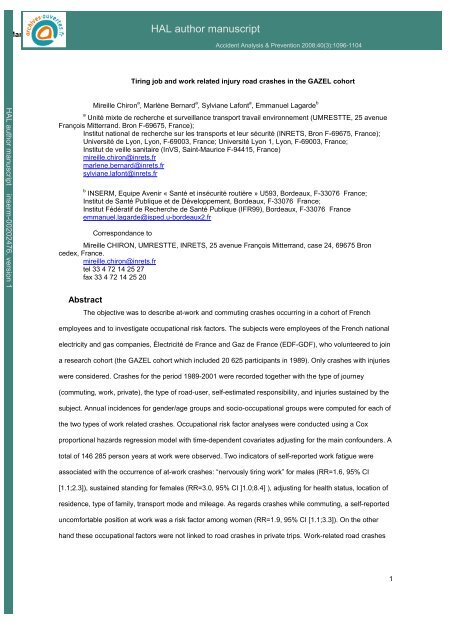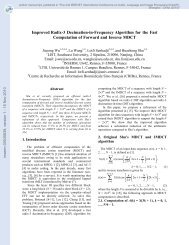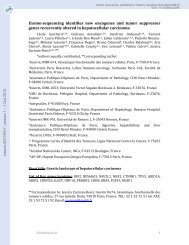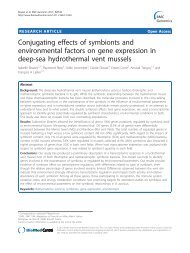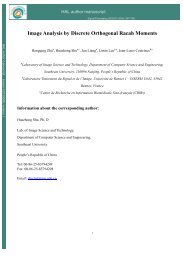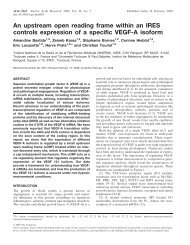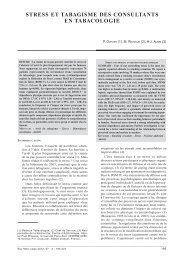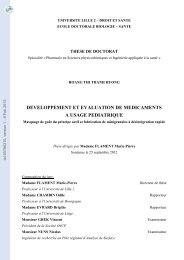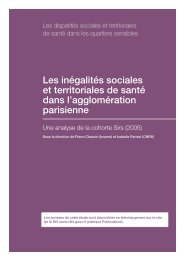Tiring job and work related injury road crashes in the GAZEL cohort.
Tiring job and work related injury road crashes in the GAZEL cohort.
Tiring job and work related injury road crashes in the GAZEL cohort.
You also want an ePaper? Increase the reach of your titles
YUMPU automatically turns print PDFs into web optimized ePapers that Google loves.
* Manuscript<br />
HAL author manuscript <strong>in</strong>serm-00202476, version 1<br />
<strong>Tir<strong>in</strong>g</strong> <strong>job</strong> <strong>and</strong> <strong>work</strong> <strong>related</strong> <strong><strong>in</strong>jury</strong> <strong>road</strong> <strong>crashes</strong> <strong>in</strong> <strong>the</strong> <strong>GAZEL</strong> <strong>cohort</strong><br />
Mireille Chiron a , Marlène Bernard a , Sylviane Lafont a , Emmanuel Lagarde b<br />
a<br />
Unité mixte de recherche et surveillance transport travail environnement (UMRESTTE, 25 avenue<br />
François Mitterr<strong>and</strong>. Bron F-69675, France);<br />
Institut national de recherche sur les transports et leur sécurité (INRETS, Bron F-69675, France);<br />
Université de Lyon, Lyon, F-69003, France; Université Lyon 1, Lyon, F-69003, France;<br />
Institut de veille sanitaire (InVS, Sa<strong>in</strong>t-Maurice F-94415, France)<br />
mireille.chiron@<strong>in</strong>rets.fr<br />
marlene.bernard@<strong>in</strong>rets.fr<br />
sylviane.lafont@<strong>in</strong>rets.fr<br />
b INSERM, Equipe Avenir « Santé et <strong>in</strong>sécurité routière » U593, Bordeaux, F-33076 France;<br />
Institut de Santé Publique et de Développement, Bordeaux, F-33076 France;<br />
Institut Fédératif de Recherche de Santé Publique (IFR99), Bordeaux, F-33076 France<br />
emmanuel.lagarde@isped.u-bordeaux2.fr<br />
Correspondance to<br />
Mireille CHIRON, UMRESTTE, INRETS, 25 avenue François Mitterr<strong>and</strong>, case 24, 69675 Bron<br />
cedex, France.<br />
mireille.chiron@<strong>in</strong>rets.fr<br />
tel 33 4 72 14 25 27<br />
fax 33 4 72 14 25 20<br />
Abstract<br />
HAL author manuscript<br />
Accident Analysis & Prevention 2008;40(3):1096-1104<br />
The objective was to describe at-<strong>work</strong> <strong>and</strong> commut<strong>in</strong>g <strong>crashes</strong> occurr<strong>in</strong>g <strong>in</strong> a <strong>cohort</strong> of French<br />
employees <strong>and</strong> to <strong>in</strong>vestigate occupational risk factors. The subjects were employees of <strong>the</strong> French national<br />
electricity <strong>and</strong> gas companies, Électricité de France <strong>and</strong> Gaz de France (EDF-GDF), who volunteered to jo<strong>in</strong><br />
a research <strong>cohort</strong> (<strong>the</strong> <strong>GAZEL</strong> <strong>cohort</strong> which <strong>in</strong>cluded 20 625 participants <strong>in</strong> 1989). Only <strong>crashes</strong> with <strong>in</strong>juries<br />
were considered. Crashes for <strong>the</strong> period 1989-2001 were recorded toge<strong>the</strong>r with <strong>the</strong> type of journey<br />
(commut<strong>in</strong>g, <strong>work</strong>, private), <strong>the</strong> type of <strong>road</strong>-user, self-estimated responsibility, <strong>and</strong> <strong>in</strong>juries susta<strong>in</strong>ed by <strong>the</strong><br />
subject. Annual <strong>in</strong>cidences for gender/age groups <strong>and</strong> socio-occupational groups were computed for each of<br />
<strong>the</strong> two types of <strong>work</strong> <strong>related</strong> <strong>crashes</strong>. Occupational risk factor analyses were conducted us<strong>in</strong>g a Cox<br />
proportional hazards regression model with time-dependent covariates adjust<strong>in</strong>g for <strong>the</strong> ma<strong>in</strong> confounders. A<br />
total of 146 285 person years at <strong>work</strong> were observed. Two <strong>in</strong>dicators of self-reported <strong>work</strong> fatigue were<br />
associated with <strong>the</strong> occurrence of at-<strong>work</strong> <strong>crashes</strong>: “nervously tir<strong>in</strong>g <strong>work</strong>” for males (RR=1.6, 95% CI<br />
[1.1;2.3]), susta<strong>in</strong>ed st<strong>and</strong><strong>in</strong>g for females (RR=3.0, 95% CI ]1.0;8.4] ), adjust<strong>in</strong>g for health status, location of<br />
residence, type of family, transport mode <strong>and</strong> mileage. As regards <strong>crashes</strong> while commut<strong>in</strong>g, a self-reported<br />
uncomfortable position at <strong>work</strong> was a risk factor among women (RR=1.9, 95% CI [1.1;3.3]). On <strong>the</strong> o<strong>the</strong>r<br />
h<strong>and</strong> <strong>the</strong>se occupational factors were not l<strong>in</strong>ked to <strong>road</strong> <strong>crashes</strong> <strong>in</strong> private trips. Work-<strong>related</strong> <strong>road</strong> <strong>crashes</strong><br />
1
HAL author manuscript <strong>in</strong>serm-00202476, version 1<br />
seem <strong>the</strong>n to be a matter for a specific prevention. Prevent<strong>in</strong>g employees from becom<strong>in</strong>g exhausted should<br />
be considered as <strong>the</strong> first way to <strong>in</strong>itiate such a prevention.<br />
Key-words: occupation, traffic, accident, risk factor, fatigue<br />
2
HAL author manuscript <strong>in</strong>serm-00202476, version 1<br />
<strong>Tir<strong>in</strong>g</strong> <strong>job</strong> <strong>and</strong> <strong>work</strong> <strong>related</strong> <strong><strong>in</strong>jury</strong> <strong>road</strong> <strong>crashes</strong> <strong>in</strong> <strong>the</strong> <strong>GAZEL</strong> <strong>cohort</strong><br />
Injury <strong>crashes</strong> occur <strong>in</strong> <strong>the</strong> course of both private trips <strong>and</strong> <strong>work</strong> <strong>related</strong> trips, <strong>the</strong> latter tak<strong>in</strong>g place<br />
ei<strong>the</strong>r dur<strong>in</strong>g <strong>the</strong> course of <strong>work</strong> or while commut<strong>in</strong>g. In France, as <strong>in</strong> several o<strong>the</strong>r countries, <strong>in</strong>juries that<br />
occur when commut<strong>in</strong>g or when at <strong>work</strong> are treated as occupational <strong>in</strong>juries for <strong>the</strong> purposes of<br />
compensation. At-<strong>work</strong> <strong>road</strong> <strong>crashes</strong> are <strong>the</strong> primary cause of occupational fatalities <strong>in</strong> most <strong>in</strong>dustrialised<br />
countries (Personick <strong>and</strong> Mush<strong>in</strong>ski, 1997; Charbotel et al., 2001), because of <strong>the</strong>ir severity. The<br />
sociodemographic characteristics of <strong>the</strong> population groups at risk differ for <strong>the</strong> three types of accidents (at-<br />
<strong>work</strong>, commut<strong>in</strong>g, or private trips) (Charbotel et al., 2001; Boufous <strong>and</strong> Williamson, 2006).<br />
Several risk factors have been identified as play<strong>in</strong>g a role <strong>in</strong> <strong>the</strong> occurrence of occupational<br />
accidents of all types. These <strong>in</strong>clude psychological factors (e.g. <strong>job</strong> satisfaction), <strong>work</strong> organisation <strong>and</strong><br />
schedul<strong>in</strong>g, <strong>the</strong> personal characteristics of employees, environmental <strong>and</strong> social conditions, <strong>in</strong> addition to<br />
specific <strong>work</strong> exposures such as chemical, physical, postural hazards (Dembe et al., 2004). For example, a<br />
prospective study conducted <strong>in</strong> Israel (Melamed et al., 1999) has shown that adverse <strong>work</strong> <strong>and</strong><br />
environmental conditions, objectively assessed <strong>and</strong> expressed as <strong>the</strong> “ergonomic stress level”, are <strong>related</strong> to<br />
<strong>the</strong> occurrence of occupational <strong>in</strong>juries even after adjustment for age, <strong>job</strong> experience, educational level,<br />
managerial status, <strong>and</strong> occupational status (white/blue collar). Chronic or acute fatigue (after a day’s <strong>work</strong>)<br />
has been specifically accused of <strong>in</strong>creas<strong>in</strong>g <strong>the</strong> risk of <strong>work</strong> accidents <strong>in</strong> <strong>the</strong> Maastricht <strong>cohort</strong> (Swaen et al.,<br />
2003). The mechanism <strong>in</strong>volved could be a reduction <strong>in</strong> <strong>the</strong> ability to ga<strong>the</strong>r <strong>in</strong>formation on dangerous<br />
situations <strong>and</strong> a reduction <strong>in</strong> <strong>the</strong> capacity to respond effectively to <strong>the</strong>m.<br />
Work <strong>related</strong> <strong>road</strong> <strong>crashes</strong> are <strong>the</strong> <strong>in</strong>terface between <strong>road</strong> <strong>crashes</strong> <strong>and</strong> <strong>work</strong> accidents. The causes<br />
of <strong>work</strong> <strong>related</strong> <strong>road</strong> <strong>crashes</strong> have been subjected to <strong>the</strong> largest amount of <strong>in</strong>vestigation <strong>in</strong> <strong>the</strong> case of<br />
professional drivers (Hakkaken <strong>and</strong> Summala, 2001; Philip, 2005; Sabbagh-Ehrlich et al., 2005;<br />
Tzamalouka, 2005; de P<strong>in</strong>ho et al., 2006) <strong>and</strong> <strong>the</strong> results have highlighted <strong>the</strong> <strong>in</strong>fluence of lack of sleep,<br />
overall <strong>work</strong>load (<strong>in</strong>clud<strong>in</strong>g <strong>work</strong> o<strong>the</strong>r than driv<strong>in</strong>g), fatigue, <strong>and</strong> chronic daytime sleep<strong>in</strong>ess. To our<br />
knowledge, outside <strong>the</strong> transport sector, occupational stresses have rarely been studied as potential risk<br />
factors for <strong>road</strong> traffic <strong>in</strong>juries. In <strong>the</strong> German medical staff (Kirkcaldy et al., 1997) <strong>the</strong> average yearly number<br />
of car accidents was predicted as a function of age <strong>and</strong> number of <strong>work</strong><strong>in</strong>g hours. Fur<strong>the</strong>rmore, driv<strong>in</strong>g<br />
accidents go<strong>in</strong>g to or com<strong>in</strong>g from <strong>work</strong> dur<strong>in</strong>g <strong>the</strong> last year was associated with <strong>work</strong><strong>in</strong>g climate, hours of<br />
<strong>work</strong>, length of lunchtime break, distance travelled to <strong>and</strong> from <strong>work</strong>, number of dependent children, <strong>and</strong><br />
3
HAL author manuscript <strong>in</strong>serm-00202476, version 1<br />
gender (more accidents among women, which was surpris<strong>in</strong>g for <strong>the</strong> authors, <strong>and</strong> which <strong>the</strong>y assumed<br />
(Kirkcaldy et al., 1997) to be specific to <strong>the</strong> occupation of medical staff). Physicians who <strong>work</strong>ed more than<br />
48 hours per week had five times <strong>the</strong> <strong>in</strong>cidence of driv<strong>in</strong>g accidents do<strong>in</strong>g house visits than <strong>the</strong>ir less time-<br />
stressed colleagues. Similarly, among American nurses (Novak <strong>and</strong> Auvil-Novak, 1996) <strong>work</strong><strong>in</strong>g 12 hour<br />
shifts was associated with an excess crash <strong>in</strong>volvement dur<strong>in</strong>g <strong>the</strong>ir commut<strong>in</strong>g trips. Lastly, this was<br />
confirmed among house doctors <strong>in</strong> <strong>the</strong> United States (Barger et al., 2005) whose over long <strong>work</strong><strong>in</strong>g hours<br />
lead to excess crash <strong>in</strong>volvement.<br />
Few studies have considered <strong>the</strong> two types of <strong>work</strong> <strong>related</strong> <strong>road</strong> accidents (Harrison et al., 1993;<br />
Charbotel et al., 2001; Mitchell et al., 2004; McNoe et al., 2005; Boufous <strong>and</strong> Williamson, 2006; de P<strong>in</strong>ho et<br />
al., 2006). Three concern Australia, one New Zeal<strong>and</strong>, <strong>and</strong> one France. Crashes while commut<strong>in</strong>g were<br />
always more numerous than <strong>crashes</strong> <strong>in</strong> <strong>the</strong> course of <strong>work</strong>, except <strong>in</strong> coroner’s records <strong>in</strong> Australia, which<br />
often did not conta<strong>in</strong> <strong>the</strong> required <strong>in</strong>formation. The higher number of driver casualties was among <strong>the</strong> 25-34<br />
years(Charbotel et al., 2001; Boufous <strong>and</strong> Williamson, 2006). Among risk factors, fatigue was po<strong>in</strong>ted out,<br />
but this notion was recorded after <strong>the</strong> crash, <strong>and</strong> its occupational orig<strong>in</strong> was ignored (Boufous <strong>and</strong><br />
Williamson, 2006). These studies underl<strong>in</strong>ed that male drivers were more likely to be <strong>in</strong>volved <strong>in</strong> a <strong>work</strong>-<br />
<strong>related</strong> traffic crash than female drivers, particularly while <strong>in</strong> <strong>the</strong> course of <strong>work</strong>, <strong>and</strong> that male drivers’<br />
<strong>crashes</strong> were <strong>the</strong> most severe. At <strong>work</strong>, truck <strong>crashes</strong> were responsible of a high severity for men, while<br />
among females, commut<strong>in</strong>g <strong>crashes</strong> were more severe than on duty ones. The authors underl<strong>in</strong>ed that<br />
develop<strong>in</strong>g prevention strategies aimed at reduc<strong>in</strong>g <strong>the</strong> burden of <strong>work</strong>-<strong>related</strong> traffic <strong>crashes</strong> requires sound<br />
knowledge of areas <strong>related</strong> to environmental, behavioural <strong>and</strong> organisational factors that contribute this type<br />
of <strong><strong>in</strong>jury</strong> (Boufous <strong>and</strong> Williamson, 2006).<br />
The aim of <strong>the</strong> present study was to assess <strong>the</strong> impact of occupational stresses on both at-<strong>work</strong> <strong>and</strong><br />
commut<strong>in</strong>g <strong><strong>in</strong>jury</strong> <strong>crashes</strong> <strong>in</strong> a <strong>cohort</strong> of employees with different occupations.<br />
1. Materials <strong>and</strong> methods<br />
1.1.Study population<br />
The subjects were employees of <strong>the</strong> French national electricity <strong>and</strong> gas companies, Électricité de<br />
France <strong>and</strong> Gaz de France (EDF-GDF), who volunteered to jo<strong>in</strong> a research <strong>cohort</strong>, known as <strong>GAZEL</strong>, whose<br />
ma<strong>in</strong> objectives are to estimate <strong>the</strong> annual prevalence <strong>and</strong> <strong>in</strong>cidence of chronic health problems. Nationwide,<br />
4
HAL author manuscript <strong>in</strong>serm-00202476, version 1<br />
<strong>the</strong> two firms have approximately 150 000 employees, represent<strong>in</strong>g a wide variety of occupations <strong>and</strong><br />
socioeconomic groups.<br />
The French National Institute of Health <strong>and</strong> Medical Research (Institut National de la Santé et de la<br />
Recherche Médicale, INSERM) has been study<strong>in</strong>g <strong>the</strong> <strong>GAZEL</strong> <strong>cohort</strong> s<strong>in</strong>ce 1989. At that time <strong>the</strong> <strong>cohort</strong> had<br />
20 625 participants: 15 011 men aged 40-50 years <strong>and</strong> 5614 women aged 35-50 years. A comprehensive<br />
database has been regularly updated with data from <strong>the</strong> human resources department, <strong>the</strong> firms’ medical<br />
<strong>in</strong>surance programme, <strong>the</strong> occupational medic<strong>in</strong>e department <strong>and</strong> annual questionnaires mailed to<br />
participants at <strong>the</strong> beg<strong>in</strong>n<strong>in</strong>g of each year. The <strong>GAZEL</strong> <strong>cohort</strong> objectives <strong>and</strong> methods have been described<br />
<strong>in</strong> more detail elsewhere (Goldberg et al., 1990).<br />
The 19 894 liv<strong>in</strong>g members of <strong>the</strong> <strong>GAZEL</strong> <strong>cohort</strong> received a questionnaire about <strong>road</strong> accidents <strong>in</strong><br />
January 2001. The questionnaire was pilot tested <strong>in</strong> December 2000 on 500 r<strong>and</strong>omly selected participants,<br />
330 of whom responded. We used <strong>the</strong>ir answers <strong>and</strong> comments to f<strong>in</strong>alise <strong>the</strong> questionnaire described<br />
below.<br />
1.2.Data<br />
1.2.1. Data from <strong>the</strong> driv<strong>in</strong>g behaviour <strong>and</strong> <strong>road</strong> safety questionnaire (survivors only)<br />
The questionnaire was designed primarily to elicit descriptions of traffic <strong>crashes</strong> over <strong>the</strong> past 12<br />
years. For this analysis <strong>the</strong> outcome studied is <strong>the</strong> occurrence of traffic <strong>crashes</strong> <strong>in</strong> which <strong>the</strong> subject was<br />
<strong>in</strong>jured dur<strong>in</strong>g <strong>the</strong> follow-up period. For each crash, <strong>the</strong> type of journey (commut<strong>in</strong>g, at-<strong>work</strong>, <strong>and</strong> private),<br />
<strong>the</strong> type of <strong>road</strong>-user, self-estimated responsibility, <strong>the</strong> location of <strong>the</strong> crash <strong>and</strong> <strong>the</strong> <strong>in</strong>juries susta<strong>in</strong>ed by <strong>the</strong><br />
subject were recorded. Mileage was estimated <strong>in</strong> 2001 from <strong>the</strong> reported number of kilometres travelled <strong>in</strong><br />
<strong>the</strong> past 12 months by all transport modes. Four categories were def<strong>in</strong>ed as <strong>the</strong> quartiles of <strong>the</strong> distribution<br />
(
HAL author manuscript <strong>in</strong>serm-00202476, version 1<br />
potentially stressful life events that occurred dur<strong>in</strong>g <strong>the</strong> last 12 months. Separation <strong>and</strong> divorce are<br />
considered <strong>in</strong> <strong>the</strong> present study, as a previous analysis has shown that this variable <strong>in</strong>fluences crash<br />
<strong>in</strong>cidence (Lagarde et al., 2004).<br />
In 1978 <strong>the</strong> company’s health <strong>in</strong>surance department set up a database to record employee health<br />
problems (Goldberg et al., 1982). This database conta<strong>in</strong>s demographic, socio-economic, <strong>and</strong> occupational<br />
data. It <strong>in</strong>cludes all <strong>the</strong> variables that relate to <strong>work</strong><strong>in</strong>g conditions, some of which have been recorded every<br />
year: be<strong>in</strong>g on call for emergencies, daily commut<strong>in</strong>g time, physically or nervously tir<strong>in</strong>g <strong>work</strong>, <strong>and</strong> <strong>work</strong><br />
satisfaction. Some o<strong>the</strong>r variables are available only for 1989 <strong>and</strong> 1990: <strong>work</strong> schedule, <strong>work</strong><strong>in</strong>g at night,<br />
<strong>work</strong><strong>in</strong>g outside, be<strong>in</strong>g <strong>in</strong> contact with <strong>the</strong> public, be<strong>in</strong>g <strong>in</strong> contact with chemical, <strong>the</strong>rmal, mechanical or<br />
electrical hazards, <strong>road</strong> accident risk <strong>in</strong> <strong>the</strong> course of <strong>work</strong>, <strong>and</strong> type of transport used when commut<strong>in</strong>g.<br />
Some were recorded <strong>in</strong> 1989, 90 <strong>and</strong> 94: postural stress (st<strong>and</strong><strong>in</strong>g or uncomfortable position), carry<strong>in</strong>g<br />
heavy loads, exposure to vibrations, cold, heat, <strong>and</strong> noise. For <strong>the</strong>se variables, we considered <strong>the</strong> last<br />
known state. As occupations were precisely recorded with <strong>the</strong> dates of any changes, we created a variable<br />
called “<strong>work</strong> change <strong>in</strong> last three months”. This database also provided deaths from <strong>road</strong> accidents. These<br />
cases (n= 16, <strong>in</strong>clud<strong>in</strong>g three while commut<strong>in</strong>g) were <strong>in</strong>cluded <strong>in</strong> <strong>the</strong> assessment of <strong>in</strong>cidences.<br />
Retirees were excluded from <strong>the</strong> present study. When study<strong>in</strong>g risk factors, only <strong>in</strong>jured drivers,<br />
riders or pedestrians were considered; passengers <strong>and</strong> unspecified <strong>in</strong>dividuals (fatalities), were excluded.<br />
1.3.Statistical analysis<br />
Annual <strong>in</strong>cidences were computed for each of <strong>the</strong> two types of <strong>work</strong> <strong>related</strong> <strong>crashes</strong>. All <strong><strong>in</strong>jury</strong><br />
<strong>crashes</strong> were taken <strong>in</strong>to account, some subjects hav<strong>in</strong>g two or three <strong>crashes</strong> <strong>in</strong> <strong>the</strong> follow-up period. The<br />
number of person years was calculated from <strong>the</strong> 1 st of January 1989 (<strong>the</strong> start of <strong>the</strong> <strong>cohort</strong>) until retirement<br />
when relevant, or until <strong>the</strong> 31 st of December 2001 for subjects who were still <strong>work</strong><strong>in</strong>g.<br />
Incidences were calculated for 9 gender/age groups (35-39 for women only; 40-44, 45-49, 50-54 <strong>and</strong><br />
55+ for both genders) <strong>and</strong> 4 socio-occupational groups (blue-collar <strong>work</strong>ers, clerical staff, middle managers,<br />
executives). Incidence rates were compared with a Wald test(Esteve et al., 1994). Injuries were coded us<strong>in</strong>g<br />
AIS 90 (AAAM, 1990), which ascribes a severity score to each <strong><strong>in</strong>jury</strong>, from 1 (m<strong>in</strong>or) to 6 (most severe). For<br />
<strong>in</strong>stance, a superficial laceration is coded as AIS 1, a closed fracture as AIS 2, an open/displaced fracture as<br />
AIS 3. AIS 4 <strong>and</strong> 5 <strong>in</strong>juries, possibly fatal, <strong>in</strong>volve <strong>in</strong>ternal organs. The overall severity for an <strong>in</strong>dividual with<br />
multiple <strong>in</strong>juries is measured by <strong>the</strong> MAIS, which is <strong>the</strong> severity of <strong>the</strong> subject’s most severe <strong><strong>in</strong>jury</strong>.<br />
6
HAL author manuscript <strong>in</strong>serm-00202476, version 1<br />
There is a noteworthy gender difference concern<strong>in</strong>g <strong>road</strong> morbidity <strong>and</strong> mortality, correspond<strong>in</strong>g to<br />
differences <strong>in</strong> <strong>the</strong> number of trips, differences <strong>in</strong> <strong>the</strong> choice of <strong>road</strong> transport types, <strong>and</strong> moreover<br />
to differences <strong>in</strong> risk-tak<strong>in</strong>g behaviours (Mart<strong>in</strong> et al., 2004). Therefore separate analyses were conducted by<br />
gender for each of <strong>the</strong> two types of crash us<strong>in</strong>g a Cox proportional hazards regression model with time<br />
dependent covariates (“last state”). The event is <strong>the</strong> first <strong><strong>in</strong>jury</strong> crash of each type dur<strong>in</strong>g <strong>the</strong> period 1989-<br />
2001. Men <strong>and</strong> women were analysed separately. For each type of crash, an adjustment model was fitted on<br />
<strong>the</strong> basis of sociodemographic factors (age, separation <strong>in</strong> <strong>the</strong> last year, liv<strong>in</strong>g alone or <strong>in</strong> a family), location of<br />
residence, health (self evaluated state of health <strong>and</strong> depression, alcohol consumption) <strong>and</strong> general mobility<br />
variables (annual mileage <strong>and</strong> <strong>road</strong> transport mode used <strong>in</strong> 2001). Commut<strong>in</strong>g time <strong>and</strong> transport mode <strong>in</strong><br />
1989 were taken <strong>in</strong>to account <strong>in</strong> <strong>the</strong> model for commut<strong>in</strong>g <strong>crashes</strong>, while self reported “at-<strong>work</strong> crash risk”<br />
was considered for at-<strong>work</strong> <strong>crashes</strong>, <strong>the</strong>se variables be<strong>in</strong>g considered as specific exposure measures for<br />
each type of trip. Occupational group was considered as an <strong>in</strong>dicator of lifestyle <strong>and</strong> st<strong>and</strong>ard of liv<strong>in</strong>g, <strong>in</strong><br />
contrast to occupational data as such (<strong>work</strong><strong>in</strong>g conditions) which are variables of <strong>in</strong>terest. In order for <strong>the</strong><br />
results to be generally applicable, precise <strong>job</strong>s (electrician…) were not studied as risk factors, but detailed<br />
exposures (last state) to specific hazards were. Only those occupational variables l<strong>in</strong>ked to each type of<br />
crash with p
HAL author manuscript <strong>in</strong>serm-00202476, version 1<br />
2.2.Incidences <strong>and</strong> characteristics of <strong>work</strong> <strong>related</strong> <strong>crashes</strong><br />
A total of 146 283 person years at <strong>work</strong> were observed, dur<strong>in</strong>g which 231 <strong>crashes</strong> occurred while<br />
commut<strong>in</strong>g (<strong>in</strong>volv<strong>in</strong>g 217 <strong>in</strong>dividuals), <strong>and</strong> 165 dur<strong>in</strong>g <strong>the</strong> course of <strong>work</strong> (160 <strong>in</strong>dividuals). Three people<br />
were killed <strong>in</strong> a crash while commut<strong>in</strong>g. The overall <strong>in</strong>cidence is thus 27.0 <strong>work</strong> <strong>related</strong> <strong><strong>in</strong>jury</strong> <strong>crashes</strong> per<br />
10 000 person years.<br />
Table 1 gives annual <strong>in</strong>cidences, by gender, for each type of <strong>work</strong> <strong>related</strong> crash, accord<strong>in</strong>g to age<br />
<strong>and</strong> occupational category. For <strong>crashes</strong> <strong>in</strong> <strong>the</strong> course of <strong>work</strong> <strong>the</strong> difference between genders is not<br />
significant, <strong>and</strong> ag<strong>in</strong>g has no clear effect, except <strong>in</strong> <strong>the</strong> case of men aged 55 years <strong>and</strong> over for whom <strong>the</strong><br />
<strong>in</strong>cidence is significantly lower (only one accident, p=0.02). Among men, blue collar <strong>work</strong>ers (p=3.10 -7 ), <strong>and</strong><br />
middle managers (p=1.10 -4 ) are more frequently concerned than executives.<br />
The <strong>in</strong>cidence of commut<strong>in</strong>g <strong>crashes</strong> is maximal under 40 years, a category which unfortunately<br />
consists only of women <strong>in</strong> our sample, <strong>and</strong> for which <strong>the</strong> <strong>in</strong>cidence is twice higher, compared to women<br />
between 40 <strong>and</strong> 44 years of age (p=0.03). Even after 40 years of age, <strong>the</strong> genders globally differ for<br />
commut<strong>in</strong>g <strong>crashes</strong> (p=7.10 -4 ). Compared to men, women have a double <strong>in</strong>cidence between 45 <strong>and</strong> 49 years<br />
of age (p=0.004) <strong>and</strong> between 50 <strong>and</strong> 54 years of age (p=0.02). Commut<strong>in</strong>g <strong>crashes</strong> are more frequent<br />
among clerical staff of both genders (men p=3.10 -4 , women p=0.02), compared to executives. Male middle<br />
managers have also a higher <strong>in</strong>cidence than executives (p=0.03). It is only among middle managers that<br />
women have a significant higher <strong>in</strong>cidence than men (p
HAL author manuscript <strong>in</strong>serm-00202476, version 1<br />
2.3.Risk factors of <strong>work</strong> <strong>related</strong> <strong>crashes</strong><br />
The analyses described below attempted to identify risk factors, <strong>and</strong> only considered <strong>crashes</strong><br />
experienced by drivers, riders or pedestrians. Thus, 109 <strong>crashes</strong> were excluded (<strong>in</strong> which 52 females <strong>and</strong> 39<br />
males passengers were <strong>in</strong>jured <strong>and</strong> 3 females <strong>and</strong> 11 males whose transport mode at <strong>the</strong> time of <strong>the</strong> crash<br />
was unspecified were killed). Eight additional subjects were excluded because <strong>the</strong>y did not provide mileage<br />
estimates <strong>in</strong> 2001.<br />
Factors relat<strong>in</strong>g to personal characteristics, lifestyle, health <strong>and</strong> occupation were assessed for <strong>the</strong>ir<br />
association with <strong>the</strong> risk of at-<strong>work</strong> <strong>and</strong> commut<strong>in</strong>g <strong>crashes</strong> for each gender (results of <strong>the</strong> univariate<br />
analysis not shown). At-<strong>work</strong> <strong>crashes</strong> were significantly l<strong>in</strong>ked to <strong>the</strong> number of days of sick leave (males<br />
with <strong>the</strong> most sick leave had more <strong>crashes</strong>), occupational category (more <strong>crashes</strong> among male blue collar<br />
<strong>work</strong>ers <strong>and</strong> middle managers), <strong>and</strong> for both genders with a self reported at-<strong>work</strong> <strong>road</strong> crash risk. This <strong>road</strong><br />
hazard at <strong>work</strong> <strong>in</strong>volved 60.3% of observed man years, but only 12.6% of observed woman years. Accidents<br />
while commut<strong>in</strong>g were <strong>the</strong> most numerous among <strong>the</strong> youngest males, clerical staff of genders, females<br />
liv<strong>in</strong>g alone or hav<strong>in</strong>g had many days of sick leave. For both genders <strong>the</strong> frequency of <strong>crashes</strong> <strong>in</strong>creased<br />
with <strong>the</strong> length of commut<strong>in</strong>g journeys. The <strong>in</strong>cidence of commut<strong>in</strong>g <strong>crashes</strong> was highest among male<br />
motorised two wheeler users, while pedestrians <strong>and</strong> public transport users were less often <strong>in</strong>volved <strong>in</strong><br />
<strong>crashes</strong> than motorists of ei<strong>the</strong>r gender. All <strong>the</strong>se variables were <strong>in</strong>cluded <strong>in</strong> <strong>the</strong> adjustment model.<br />
Table 3 gives <strong>the</strong> crude relative risks by gender for occupational characteristics <strong>and</strong> each type of<br />
<strong>work</strong> <strong>related</strong> crash. Work<strong>in</strong>g night shifts, contact with <strong>the</strong> public, vibrations, <strong>the</strong>rmal stress, <strong>and</strong> noise were<br />
associated with at-<strong>work</strong> <strong>crashes</strong> among males. Contact with <strong>the</strong> public, susta<strong>in</strong>ed st<strong>and</strong><strong>in</strong>g, carry<strong>in</strong>g heavy<br />
loads, vibrations <strong>and</strong> <strong>the</strong>rmal stress were associated with at-<strong>work</strong> <strong>crashes</strong> among females. An uncomfortable<br />
position at <strong>work</strong> was associated with commut<strong>in</strong>g <strong>crashes</strong> among females.<br />
Table 4 gives RR (significant for at least one column) for <strong>work</strong> <strong>related</strong> <strong>and</strong> general risk factors, obta<strong>in</strong>ed from<br />
a Cox proportional hazards regression model adjust<strong>in</strong>g for age, transport habits (total vehicle kilometres<br />
travelled, self reported <strong>road</strong> risk at <strong>work</strong> for at-<strong>work</strong> <strong>crashes</strong>, km travelled <strong>and</strong> type of vehicle for commut<strong>in</strong>g<br />
<strong>crashes</strong>), health <strong>and</strong> personal characteristics, <strong>and</strong> socio-occupational category. “Nervously tir<strong>in</strong>g <strong>work</strong>” for<br />
males <strong>and</strong> susta<strong>in</strong>ed st<strong>and</strong><strong>in</strong>g for females were associated with at-<strong>work</strong> <strong>crashes</strong>. An uncomfortable position<br />
at <strong>work</strong> was associated with commut<strong>in</strong>g <strong>crashes</strong> for females, toge<strong>the</strong>r with bad life circumstances (liv<strong>in</strong>g<br />
alone, many days of sick leave).<br />
9
HAL author manuscript <strong>in</strong>serm-00202476, version 1<br />
The same analysis was conducted on accidents occurr<strong>in</strong>g dur<strong>in</strong>g private journeys (results not<br />
shown). No l<strong>in</strong>k was found with any occupational constra<strong>in</strong>t, except that those who were exposed to <strong>road</strong><br />
crash risk at <strong>work</strong> were less likely to have a crash <strong>in</strong> <strong>the</strong>ir private life.<br />
Discussion, conclusions<br />
Because of its age (35-60), <strong>the</strong> study population is particular as regards <strong>work</strong> <strong>related</strong> accidents <strong>and</strong><br />
<strong>road</strong> <strong>crashes</strong>. Indeed <strong>work</strong> <strong>related</strong> <strong>in</strong>juries are generally known to be more frequent among young<br />
employees, especially men.(Salm<strong>in</strong>en, 2004) In <strong>the</strong> French population as a whole, <strong>the</strong> frequency of <strong>work</strong><br />
<strong>related</strong> traffic <strong>in</strong>juries is <strong>the</strong> highest among 25-34 year olds <strong>and</strong> decreases steadily with age,(Charbotel et al.,<br />
2001) <strong>and</strong> <strong>the</strong> situation is exactly <strong>the</strong> same <strong>in</strong> Australia.(Boufous <strong>and</strong> Williamson, 2006). We can thus state<br />
that we studied a group with a fairly low risk of <strong><strong>in</strong>jury</strong> <strong>crashes</strong>. Moreover, some biases exist both at <strong>the</strong><br />
beg<strong>in</strong>n<strong>in</strong>g of <strong>the</strong> <strong>cohort</strong> <strong>and</strong> <strong>the</strong>reafter due to <strong>the</strong> fact that participation <strong>in</strong> <strong>the</strong> <strong>GAZEL</strong> <strong>cohort</strong> was voluntary,<br />
<strong>and</strong> <strong>the</strong> participation rate (Goldberg et al., 2001) is l<strong>in</strong>ked to gender, education, <strong>job</strong> grade, family status,<br />
health, <strong>and</strong> residence <strong>in</strong> particular regions. Groups with favourable family, health or socioeconomic<br />
characteristics are overrepresented among volunteers. On <strong>the</strong> o<strong>the</strong>r h<strong>and</strong>, occupational exposures had no<br />
effect on participation adjusted for social <strong>and</strong> demographic variables. Among men, but not women, diseases<br />
caused by alcohol, smok<strong>in</strong>g, <strong>and</strong> dangerous behaviour (accidents) were <strong>the</strong> primary reason for <strong>the</strong> health<br />
differences observed between participants <strong>and</strong> non-participants. It is <strong>the</strong>refore possible that some subjects<br />
ceased to participate <strong>in</strong> <strong>the</strong> study due to a severe <strong><strong>in</strong>jury</strong> crash. Only fatal <strong>crashes</strong> were re<strong>in</strong>troduced <strong>in</strong>to <strong>the</strong><br />
data <strong>in</strong> order to compute <strong>in</strong>cidences as o<strong>the</strong>r severe <strong>crashes</strong>, that might have been <strong>the</strong> cause of non-<br />
participation, be<strong>in</strong>g unknown. All <strong>in</strong> all, it is possible that <strong>the</strong> <strong>in</strong>cidences calculated here are underestimated<br />
due to participation bias; however <strong>the</strong> assessment of occupational risk factors is valid given that o<strong>the</strong>r<br />
personal risk factors have been taken <strong>in</strong>to account.<br />
The higher risk for women while commut<strong>in</strong>g, which is responsible for <strong>the</strong>ir higher overall <strong>work</strong> <strong>related</strong><br />
crash risk, was observed nei<strong>the</strong>r <strong>in</strong> <strong>the</strong> general French population <strong>in</strong>clud<strong>in</strong>g non-<strong>work</strong><strong>in</strong>g women,(Charbotel<br />
et al., 2001) nor <strong>in</strong> Australia.(Boufous <strong>and</strong> Williamson, 2006) Commut<strong>in</strong>g risk was very high for women aged<br />
under 40 years, but <strong>the</strong>re were no men <strong>in</strong> <strong>the</strong> same age group <strong>in</strong> <strong>the</strong> <strong>cohort</strong>. The greater risk for commut<strong>in</strong>g<br />
accidents among young male <strong>and</strong> female blue collar <strong>work</strong>ers has also been observed <strong>in</strong> national data<br />
(Charbotel et al., 2001) <strong>and</strong> by Boufous et al.(Boufous <strong>and</strong> Williamson, 2006). The difference between<br />
genders for <strong>the</strong> <strong>in</strong>cidence of commut<strong>in</strong>g <strong>crashes</strong> is also significant <strong>in</strong> <strong>the</strong> present study for <strong>the</strong> entire <strong>work</strong><strong>in</strong>g<br />
10
HAL author manuscript <strong>in</strong>serm-00202476, version 1<br />
life after 40 years of age. Our study <strong>the</strong>refore confirms <strong>the</strong> results of Kirkcaldy <strong>and</strong> al.(Kirkcaldy et al., 1997)<br />
<strong>in</strong> a very different <strong>work</strong><strong>in</strong>g population. Women’s commut<strong>in</strong>g journeys are often more complex <strong>and</strong><br />
fragmented than men’s due to domestic shopp<strong>in</strong>g trips <strong>and</strong> tak<strong>in</strong>g children to <strong>and</strong> from school.(McGuck<strong>in</strong><br />
<strong>and</strong> Murakami, 1999) In our sample, women liv<strong>in</strong>g alone seem to be <strong>the</strong> most exposed to <strong>road</strong>-<strong>crashes</strong>.<br />
Therefore chores can hardly be blamed. Be<strong>in</strong>g aged 40 <strong>and</strong> more, women liv<strong>in</strong>g alone may mostly be<br />
divorced or separated, <strong>and</strong> we can <strong>the</strong>n, on <strong>the</strong> contrary, suppose that lonely women behave less carefully <strong>in</strong><br />
<strong>road</strong> traffic. On <strong>the</strong> o<strong>the</strong>r h<strong>and</strong>, women generally use two wheeled vehicles less often <strong>and</strong> are <strong>the</strong>refore less<br />
exposed to traffic <strong>crashes</strong>. In our sample, 7% of men <strong>and</strong> 1% of women commuted by two wheeled vehicle<br />
while 19% <strong>and</strong> 26% respectively reported commut<strong>in</strong>g exclusively by foot <strong>and</strong>/or public transportation.<br />
Women who had had a large number of days sick leave also exhibited excess crash <strong>in</strong>volvement while<br />
commut<strong>in</strong>g, <strong>in</strong> spite of <strong>the</strong>ir lower number of days of exposure. This factor could be <strong>related</strong> to chronic<br />
fatigue, such as that measured by Swaen (Swaen et al., 2003), which is l<strong>in</strong>ked to <strong>the</strong> general <strong>in</strong>cidence of<br />
<strong>work</strong> accidents. All th<strong>in</strong>gs considered, this excess of commut<strong>in</strong>g accidents among middle-aged active<br />
women, compared to men, is worth not<strong>in</strong>g. Fur<strong>the</strong>r studies are required as it is very rare to f<strong>in</strong>d an excess of<br />
accidents among women, ei<strong>the</strong>r at <strong>work</strong> or <strong>in</strong> <strong>road</strong> traffic.<br />
The <strong>in</strong>cidence of at-<strong>work</strong> <strong>crashes</strong> was slightly greater for men than for women even if <strong>the</strong> difference<br />
between genders was not significant, <strong>and</strong> was much smaller than has been observed <strong>in</strong> previous studies.<br />
(Harrison et al., 1993; Personick <strong>and</strong> Mush<strong>in</strong>ski, 1997; Charbotel et al., 2001; CDC, 2004; Mitchell et al.,<br />
2004; Boufous <strong>and</strong> Williamson, 2006)<br />
However, we have found no published study that takes account of <strong>the</strong> number of <strong>work</strong><strong>in</strong>g years when<br />
compar<strong>in</strong>g at-<strong>work</strong> crash risk, an adjustment which was feasible here as <strong>the</strong> denom<strong>in</strong>ator for <strong>in</strong>cidence only<br />
<strong>in</strong>cludes people at <strong>work</strong>. It is <strong>the</strong>refore possible that a considerable proportion of <strong>the</strong> excess <strong>in</strong>volvement<br />
rates for men that are observed <strong>in</strong> <strong>the</strong>se studies with crude results for commut<strong>in</strong>g <strong>and</strong> at-<strong>work</strong> <strong>crashes</strong> is<br />
attributable to a gender difference <strong>in</strong> employment rates.<br />
Both mileage <strong>and</strong> <strong>the</strong> type of vehicle used for commut<strong>in</strong>g, as measured <strong>in</strong> 1989, were associated<br />
with commut<strong>in</strong>g <strong>crashes</strong>. Similarly, self reported “risk of a <strong>road</strong> crash at <strong>work</strong>”, as measured <strong>in</strong> 1989 <strong>and</strong><br />
1990, is associated with at-<strong>work</strong> <strong>crashes</strong> over <strong>the</strong> whole period suggest<strong>in</strong>g that transport habits both at <strong>work</strong><br />
<strong>and</strong> while commut<strong>in</strong>g have rema<strong>in</strong>ed very constant for most <strong>in</strong>dividuals over a 12 year period.<br />
At-<strong>work</strong> <strong>road</strong> <strong>crashes</strong> were less severe than commut<strong>in</strong>g ones. This has already been reported from a<br />
comprehensive analysis of all <strong>road</strong> <strong>crashes</strong> <strong>in</strong> France us<strong>in</strong>g police data. (Charbotel et al., 2001) Overall<br />
11
HAL author manuscript <strong>in</strong>serm-00202476, version 1<br />
<strong><strong>in</strong>jury</strong> severity, as measured by <strong>the</strong> MAIS, <strong>in</strong>creases with age which concurs with previous studies that show<br />
an <strong>in</strong>crease with age for both occupational <strong>in</strong>juries (Salm<strong>in</strong>en, 2004) <strong>and</strong> <strong>road</strong> <strong>in</strong>juries.(Ryan et al., 1998)<br />
The most likely explanation for this is <strong>the</strong> lower vulnerability of young people to impacts. Men’s <strong>in</strong>juries are<br />
much more severe, as already shown elsewhere. (Charbotel et al., 2001; Boufous <strong>and</strong> Williamson, 2006)<br />
The major result of this analysis is <strong>the</strong> <strong>in</strong>fluence of tir<strong>in</strong>g <strong>work</strong> conditions (measured by “nervously<br />
tir<strong>in</strong>g <strong>work</strong>” or “susta<strong>in</strong>ed st<strong>and</strong><strong>in</strong>g”) on <strong>the</strong> <strong>in</strong>cidence of at-<strong>work</strong> <strong>crashes</strong>. Even more <strong>in</strong>structive is <strong>the</strong> l<strong>in</strong>k<br />
between commut<strong>in</strong>g accidents <strong>and</strong> tir<strong>in</strong>g <strong>work</strong> conditions (uncomfortable susta<strong>in</strong>ed position) among women,<br />
after adjust<strong>in</strong>g for health status, residence location, family life <strong>and</strong> commut<strong>in</strong>g behaviour (distance <strong>and</strong><br />
mode). The significance of <strong>the</strong>se f<strong>in</strong>d<strong>in</strong>gs is fur<strong>the</strong>r <strong>in</strong>creased by <strong>the</strong> fact that <strong>the</strong> risk of non-<strong>work</strong> <strong>related</strong><br />
<strong>crashes</strong> <strong>in</strong> <strong>the</strong> same <strong>cohort</strong> was not associated with any of available occupational variables. The same<br />
process is <strong>the</strong>refore present <strong>in</strong> <strong>work</strong> <strong>related</strong> <strong>crashes</strong> <strong>and</strong> <strong>work</strong> accidents <strong>in</strong> general, both of <strong>the</strong>m be<strong>in</strong>g<br />
associated with <strong>the</strong> fatigue that is created by <strong>work</strong>. (Swaen et al., 2003)<br />
Road traffic accidents be<strong>in</strong>g <strong>the</strong> most serious <strong>work</strong> <strong>related</strong> accidents, this study suggests that<br />
improv<strong>in</strong>g <strong>work</strong><strong>in</strong>g conditions should be considered as a way of reduc<strong>in</strong>g not only <strong>the</strong> number of <strong>in</strong>dustrial<br />
accidents, but also <strong>the</strong> number of <strong>road</strong> traffic accidents that occur while at <strong>work</strong> <strong>and</strong> while commut<strong>in</strong>g.<br />
Aknowledgements<br />
The authors thank all those who supported this <strong>work</strong>, <strong>in</strong> particular <strong>the</strong> staff of INSERM Research Unit<br />
687. Very special thanks are due to Sébastien Bonenfant, Jean-François Chastang, Alice Gueguen, Marcel<br />
Goldberg <strong>and</strong> Marie Z<strong>in</strong>s.<br />
The project was funded by Électricité de France, Gaz de France, Fondation MAIF, Renault <strong>and</strong> INRS<br />
(Institut national de recherche et de sécurité)<br />
References<br />
AAAM, 1990. The abbreviated <strong><strong>in</strong>jury</strong> scale, 1990 revision. Des Pla<strong>in</strong>es, Ill<strong>in</strong>ois, 60018 USA, 74.<br />
Barger, L.K., Cade, B.E., Ayas, N.T., Cron<strong>in</strong>, J.W., Rosner, B., Speizer, F.E.,Czeisler, C.A., 2005. Extended<br />
<strong>work</strong> shifts <strong>and</strong> <strong>the</strong> risk of motor vehicle <strong>crashes</strong> among <strong>in</strong>terns. N Eng J Med 352 (2), 124-35.<br />
Boufous, S.,Williamson, A., 2006. Work-<strong>related</strong> traffic <strong>crashes</strong>: a record l<strong>in</strong>kage study. Accid Anal Prev 38<br />
(1), 14-21.<br />
CDC, 2004. Work-<strong>related</strong> <strong>road</strong>way <strong>crashes</strong> United States, 1992-2002. MMWR Morb Mortal Wkly Rep 53<br />
(12), 260-264.<br />
Charbotel, B., Chiron, M., Mart<strong>in</strong>, J.L.,Bergeret, A., 2001. Work-<strong>related</strong> <strong>road</strong> accidents <strong>in</strong> France. European<br />
Journal of Epidemiology 17 (8), 773-8.<br />
de P<strong>in</strong>ho, R.S., da Silva-Junior, F.P., Bastos, J.P., Maia, W.S., de Mello, M.T., de Bru<strong>in</strong>, V.M.,de Bru<strong>in</strong>, P.F.,<br />
2006. Hypersomnolence <strong>and</strong> accidents <strong>in</strong> truck drivers: A cross-sectional study. Chronobiol Int 23<br />
(5), 963-71.<br />
12
HAL author manuscript <strong>in</strong>serm-00202476, version 1<br />
Dembe, A., Erickson, J.B.,Delbos, R., 2004. Predictors of <strong>work</strong>-<strong>related</strong> <strong>in</strong>juries <strong>and</strong> illnesses : national survey<br />
f<strong>in</strong>d<strong>in</strong>gs. Journal of Occupational <strong>and</strong> Environmental Hygiene 1, 542-550.<br />
Esteve, J., Benhamou, E.,Raymond, L. 1994. Statistical methods <strong>in</strong> cancer research, vol 4: descriptive<br />
emidemiology. Lyon, International Agency for Research on Cancer (WHO).<br />
Goldberg, M., Blanc, M., Chastang, J.F., Blanc, C.,Sommer, M., 1982. The health data base of a nationwide<br />
company- its use <strong>in</strong> epidemiological studies. J Occupational Med 24 (1), 47-52.<br />
Goldberg, M., Chastang, J.F., Leclerc, A., Z<strong>in</strong>s, M., Bonenfant, S., Bugel, I., Kaniewski, N., Schmaus, A.,<br />
Niedhammer, I., Piciotti, M., Chevalier, A., Godard, C.,Imbernon, E., 2001. Socioeconomic,<br />
demographic, occupational, <strong>and</strong> health factors associated with participation <strong>in</strong> a long-term<br />
epidemiologi survey: a prospective study of <strong>the</strong> French <strong>GAZEL</strong> <strong>cohort</strong> <strong>and</strong> uts target population. Am<br />
J Epidemiol 154 (4), 373-383.<br />
Goldberg, M., Leclerc, A., Chastang, J.F., Morcet, J.F., Marne, M.J., Luce, D.,Boumendil, E., 1990. Mise en<br />
place d'une <strong>cohort</strong>e épidémiologique à Électricité de France - Gaz de France. Recrutement des<br />
volontaires. Pr<strong>in</strong>cipales caractéristiques de l'échantillon. Rev. Epidém. et Santé Publ. 38, 265-268<br />
378-380.<br />
Hakkaken, H.,Summala, H., 2001. Fatal traffic accidents among trailer truck drivers <strong>and</strong> accident causes as<br />
viewed by o<strong>the</strong>r truck drivers. Accid Anal Prev 33 (2), 187-96.<br />
Harrison, J.E., M<strong>and</strong>ryk, J.A.,Frommer, M.S., 1993. Work-<strong>related</strong> <strong>road</strong> fatalities <strong>in</strong> Australia, 1982-1984.<br />
Accid Anal Prev 25 (4), 443-451.<br />
Kirkcaldy, B.D., Trimpop, R.,Cooper, C.L., 1997. Work<strong>in</strong>g hours, <strong>job</strong> stress, <strong>work</strong> satisfaction <strong>and</strong> accident<br />
rates among medical practitioners <strong>and</strong> allied personnel. Int J Stress Management 4 (2), 79-87.<br />
Lagarde, E., Chastang, J.F., Gueguen, A., Chiron, M., Coeuret-Pellicier, M.,Lafont, S., 2004. Emotional<br />
stress <strong>and</strong> traffic accidents: <strong>the</strong> impact of separation <strong>and</strong> divorce. Epidemiology 15 (6), 762-766.<br />
Mart<strong>in</strong>, J.L., Lafont, S., Chiron, M., Gagegbeku, B.,Laumon, B., 2004. Différences entre les hommes et les<br />
femmes face au risque routier. Revue d’épidémiologie et de santé publique 52, 357-367.<br />
McGuck<strong>in</strong>, N.,Murakami, E., 1999. Exam<strong>in</strong><strong>in</strong>g trip-cha<strong>in</strong><strong>in</strong>g behavior - Comparison of travel by men <strong>and</strong><br />
women. Transportation research record 1693, 79-85.<br />
McNoe, B., Langley, J.,Feyer, A.M., 2005. Work-<strong>related</strong> fatal traffic <strong>crashes</strong> <strong>in</strong> New Zeal<strong>and</strong>: 1985-1998. N Z<br />
Med J 118 (1227), U1783.<br />
Melamed, S., Yekutieli, D., Froom, P., Kristal-Boneh, E.,Ribak, J., 1999. Adverse <strong>work</strong> <strong>and</strong> environmental<br />
conditions predict occupational <strong>in</strong>juries. The Israeli cardiovascular occupational risk factors<br />
determ<strong>in</strong>ation <strong>in</strong> Israël (CORDIS) study. Am J Epidemiol 150, 18-26.<br />
Mitchell, R., Driscoll, T.,Healey, S., 2004. Work-<strong>related</strong> <strong>road</strong> fatalities <strong>in</strong> Australia. Accid Anal Prev 36 (5),<br />
851-60.<br />
Novak, R.D.,Auvil-Novak, S.E., 1996. Focus group evaluation of night nurse shif<strong>work</strong> difficulties <strong>and</strong> cop<strong>in</strong>g<br />
strategies. Chronobiol Int 13 (6), 457-63.<br />
Personick, M.,Mush<strong>in</strong>ski, M., 1997. Highway fatalities: lead<strong>in</strong>g cause of <strong>work</strong>-<strong>related</strong> deaths. Stat Bull Metrop<br />
<strong>in</strong>sur Co 78 (2), 19-25.<br />
Philip, P., 2005. Sleep<strong>in</strong>ess of accupational drivers. Ind Health 43 (1), 30-33.<br />
Ryan, G.A., Legge, M.,Rosman, D., 1998. Age <strong>related</strong> changes <strong>in</strong> driver's crash risk <strong>and</strong> crash type. Accid<br />
Anal Prev 30 (3), 379-387.<br />
Sabbagh-Ehrlich, S., Friedman, L.,Richter, E.D., 2005. Work<strong>in</strong>g conditions <strong>and</strong> fatique <strong>in</strong> professional trck<br />
drivers at Israeli ports. Inj Prev 11 (2), 110-114.<br />
Salm<strong>in</strong>en, S., 2004. Have young <strong>work</strong>ers more <strong>in</strong>juries than older ones ? An <strong>in</strong>ternational literature review.<br />
Journal of Safety Research 35, 513-521.<br />
Swaen, G.M.H., van Amelsvoort, L.G.P.M., Bültmann, U.,Kant, I.J., 2003. Fatigue as a risk factor for be<strong>in</strong>g<br />
<strong>in</strong>jured <strong>in</strong> an occupational accident: results from <strong>the</strong> Maastricht Cohort Study. Occup Envir Med 60<br />
(suppl1), i88-i92.<br />
Tzamalouka, G., 2005. Freignt transport <strong>and</strong> non-driv<strong>in</strong>g <strong>work</strong> duties as predictors of fall<strong>in</strong>g asleep ay <strong>the</strong><br />
wheel <strong>in</strong> urban areas of Crete. J Safety Res 36 (1), 75-84.<br />
13
HAL author manuscript <strong>in</strong>serm-00202476, version 1<br />
Table 1 Work <strong>related</strong> <strong><strong>in</strong>jury</strong> <strong>road</strong> <strong>crashes</strong> between 1989 <strong>and</strong> 2001: <strong>in</strong>cidence per 10,000 person years<br />
Age<br />
[35-40[<br />
[40-45[<br />
[45-50[<br />
[50-55[<br />
55+<br />
Occupational category<br />
Executives<br />
Middle managers<br />
Clerical staff<br />
Blue collar <strong>work</strong>ers<br />
accord<strong>in</strong>g to age <strong>and</strong> occupational category<br />
n=14,216 <strong>in</strong>dividuals, 146,283 person years<br />
Person years<br />
At-<strong>work</strong><br />
165 <strong>crashes</strong><br />
Commut<strong>in</strong>g<br />
231 <strong>crashes</strong><br />
Incidence Incidence<br />
men women men women men women<br />
-<br />
15,601<br />
41,943<br />
43,533<br />
5,707<br />
41,119<br />
54,080<br />
3,007<br />
8,578<br />
3,262<br />
9,838<br />
14,451<br />
10,042<br />
1,906<br />
4,861<br />
26,459<br />
7,970<br />
209<br />
-<br />
13.5<br />
13.8<br />
11.7<br />
1.8<br />
6.1<br />
14.8<br />
10.0<br />
26.8<br />
6.1<br />
7.1<br />
10.4<br />
9.0<br />
5.2<br />
6.2<br />
9.4<br />
7.5<br />
-<br />
-<br />
17.3<br />
11.9<br />
12.4<br />
17.5<br />
10.0<br />
14.9<br />
32.7<br />
12.0<br />
Total 106,784 39,499 12.3 8.6 13.2 22.8<br />
39.8<br />
18.3<br />
22.8<br />
21.9<br />
21.1<br />
12.3<br />
21.5<br />
33.9<br />
-<br />
14
HAL author manuscript <strong>in</strong>serm-00202476, version 1<br />
Type of <strong>road</strong> user when <strong>in</strong>jured<br />
passenger<br />
pedestrian<br />
bicycle rider<br />
motorised 2-wheeler rider<br />
car driver<br />
commercial vehicle, or truck driver<br />
o<strong>the</strong>r, unspecified*<br />
Table 2. Characteristics of <strong>work</strong> <strong>related</strong> <strong><strong>in</strong>jury</strong> <strong>road</strong> <strong>crashes</strong><br />
Location<br />
urban <strong>road</strong><br />
o<strong>the</strong>r <strong>road</strong> o<strong>the</strong>r than motorway<br />
motorway<br />
o<strong>the</strong>r, unspecified*<br />
Responsibility (self-reported)<br />
Unspecified*<br />
Not at fault<br />
At fault<br />
*<strong>in</strong>clud<strong>in</strong>g fatalities<br />
At-<strong>work</strong> Commut<strong>in</strong>g<br />
men women men women<br />
n <strong>crashes</strong> 131 34 141 90<br />
n <strong>in</strong>dividuals 128 32 132 85<br />
% % % %<br />
Injury severity<br />
unspecified<br />
MAIS 1<br />
MAIS 2<br />
MAIS 3<br />
MAIS 4<br />
MAIS 5<br />
Fatality<br />
9.9<br />
3.8<br />
2.3<br />
2.3<br />
64.1<br />
16.8<br />
0.8<br />
47.3<br />
37.4<br />
10.7<br />
4.6<br />
0.8<br />
77.0<br />
19.9<br />
1.5<br />
0.8<br />
-<br />
-<br />
2.3<br />
75.6<br />
22.1<br />
17.7<br />
-<br />
-<br />
-<br />
73.5<br />
8.8<br />
-<br />
35.3<br />
41.2<br />
20.6<br />
2.9<br />
-<br />
91.2<br />
5.9<br />
2.9<br />
-<br />
-<br />
-<br />
2.9<br />
76.4<br />
20.5<br />
2.8<br />
5.7<br />
15.6<br />
27.7<br />
45.4<br />
0.7<br />
2.1<br />
58.2<br />
26.2<br />
10.7<br />
4.9<br />
5.0<br />
59.5<br />
29.8<br />
4.3<br />
0.7<br />
-<br />
0.7<br />
4.3<br />
56.7<br />
39.0<br />
6.7<br />
11.1<br />
1.1<br />
1.1<br />
74.4<br />
-<br />
5.6<br />
60.0<br />
21.1<br />
12.3<br />
6.6<br />
4.5<br />
72.2<br />
17.8<br />
2.2<br />
1.1<br />
-<br />
2.2<br />
3.3<br />
66.7<br />
30.0<br />
15
HAL author author manuscript <strong>in</strong>serm-00202476, version version 1<br />
Table 3. Occupational factors <strong>and</strong> <strong>work</strong> <strong>related</strong> <strong><strong>in</strong>jury</strong> <strong>crashes</strong>: univariate models<br />
Crude relative risks<br />
At <strong>work</strong> <strong><strong>in</strong>jury</strong> crash Commut<strong>in</strong>g <strong><strong>in</strong>jury</strong> crash<br />
Occupational stresses<br />
Men<br />
Women<br />
Men Women<br />
106 280 person years<br />
39 113 person years<br />
RR 95%CI Person years RR 95%CI Person years RR 95%CI RR 95%CI<br />
Physically tir<strong>in</strong>g <strong>work</strong><br />
no 1<br />
yes 1.5 ‡<br />
-<br />
91 547<br />
1<br />
0.9 to 2.3 14 733 1.9 ‡<br />
-<br />
35 168<br />
1 -<br />
1 -<br />
0.7 to 5.2 3 945 1.0 0.6 to 1.7 1.0 0.4 to 2.1<br />
Nervously tir<strong>in</strong>g <strong>work</strong><br />
no 1<br />
yes 1.4 ‡<br />
-<br />
46 612<br />
1 -<br />
20 917<br />
1 -<br />
1<br />
0.9 to 2.0 59 668 1.1 0.5 to 2.4 18 196 0.8 0.6 to 1.2 1.4 ‡<br />
-<br />
0.9 to 2.2<br />
Night shift<br />
never 1 -<br />
61 283<br />
37 698<br />
1<br />
sometimes 1.5* 1.1 to 2.3 39 228<br />
1 378 0.8<br />
regular 0.8 0.3 to 2.2 5 769<br />
37<br />
‡<br />
-<br />
0.5 to 1.1<br />
0.7 0.3 to 1.6<br />
Night shift<br />
no<br />
1 -<br />
37 698<br />
1 -<br />
yes (at least sometimes)<br />
Contact with <strong>the</strong> public<br />
2.2 0.5 to 9.5 1 415<br />
0.4 0.1 to 2.7<br />
no 1 -<br />
66 140<br />
1 -<br />
24 554<br />
1 -<br />
1 -<br />
yes 2.2*** 1.5 to 3.1 40 140 2.3* 1.1 to 5.0 14 559 1.1 0.8 to 1.6 1.1 0.7 to 1.8<br />
Susta<strong>in</strong>ed st<strong>and</strong><strong>in</strong>g<br />
no 1<br />
yes 1.3 ‡<br />
-<br />
-<br />
81 562<br />
1 1.7 to 12.2 37 188<br />
1<br />
0.9 to 2.0 24 718 4.6**<br />
1 925 1.3 ‡<br />
-<br />
1 -<br />
O<strong>the</strong>r uncomfortable position<br />
0.9 to 1.9 1.1 0.4 to 3.1<br />
no 1 -<br />
95 361<br />
1 -<br />
34 591<br />
1<br />
yes 1.0 0.5 to 1.8 10 919 1.4 0.5 to 4.0 4 522 1.6 ‡<br />
-<br />
1 -<br />
Carry<strong>in</strong>g heavy loads<br />
1.0 to 2.5 2.0* 1.1 to 3.6<br />
no 1 -<br />
96 275<br />
1 -<br />
37 401<br />
1 -<br />
1 -<br />
yes<br />
Vibrations<br />
1.0 0.5 to 1.9 10 005 3.7* 1.4 to 11.5 1 712 0.6 0.3 to 1.3 0.9 0.3 to 3.0<br />
no 1 -<br />
98 133<br />
1 -<br />
38 905<br />
1 -<br />
1 -<br />
yes<br />
Thermal stress<br />
2.3** 1.4 to 3.8 8 147 7.5* 1.0 to 55.4 208 1.0 0.5 to 2.0 1.0 0.5 to 2.0<br />
no 1 -<br />
39 138<br />
1 -<br />
35 887<br />
1 -<br />
1 -<br />
yes<br />
Noise<br />
3.0*** 1.8 to 4.9 67 142 4.2** 1.7 to 9.9 3 226 0.8 0.6 to 1.1 0.8 0.3 to 2.1<br />
no 1 -<br />
79 072<br />
1 -<br />
28 944<br />
1 -<br />
1<br />
yes 1.7* 1.1 to 2.7 14 773 0.9 0.3 to 2.6 6 062 1.3 0.8 to 2.0 1.6<br />
unknown 0.8 0.4 to 1.6 12 435 0.7 0.2 to 3.0 4 107 0.8 0.5 to 1.5<br />
‡<br />
-<br />
0.9 to 2.7<br />
Self-reported risk of a <strong>road</strong><br />
accident at <strong>work</strong><br />
0.9 0.4 to 2.0<br />
a<br />
no 1<br />
-<br />
42 243 1<br />
-<br />
34 177<br />
1 -<br />
1 -<br />
yes 3.9*** 2.3 to 6.6 64 037 3.1** 1.3 to 7.1 4 936 1.0 0.7 to 1.4 0.9 0.4 to 1.8<br />
‡<br />
0,05


